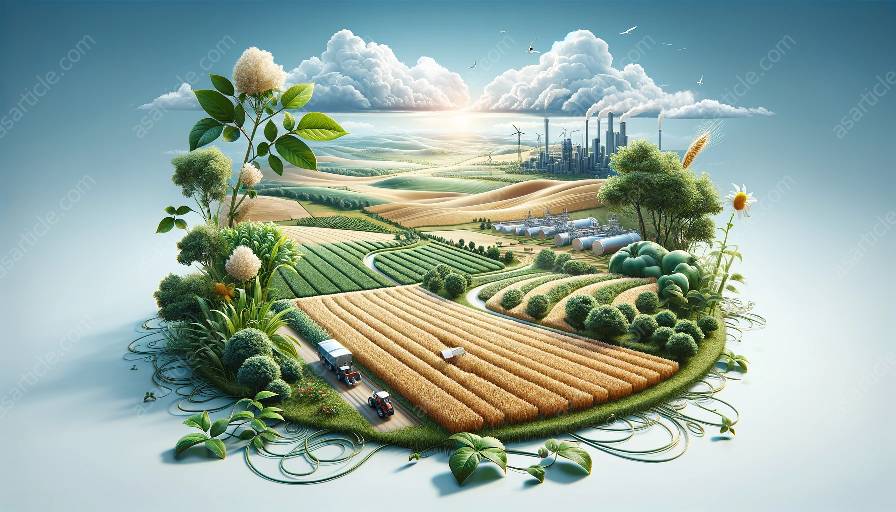When we talk about the diverse range of organisms that make up a particular ecosystem, we are referring to biodiversity. This includes everything from the tiniest microbes to the largest animals, as well as the different plant species. Biodiversity is crucial for the health of our planet and is essential for a sustainable and thriving environment. However, in recent decades, the expansion and intensification of agriculture have significantly contributed to the loss of biodiversity globally.
Impacts of Agriculture on Biodiversity Loss
Agriculture has had both direct and indirect impacts on biodiversity loss. One direct consequence is the conversion of natural habitats into agricultural land. As the human population grows, the demand for food increases, leading to the clearance of forests, wetlands, and grasslands. This reduces the available habitat for countless species, resulting in population decline and, in some cases, extinction.
Furthermore, agricultural practices such as the use of pesticides and fertilizers can have detrimental effects on biodiversity. Pesticides, designed to control pests and diseases, often do not discriminate and can harm non-target organisms, including beneficial insects, birds, and mammals. Additionally, the excessive use of fertilizers can lead to eutrophication of water bodies, causing algal blooms and disrupting aquatic ecosystems.
Another indirect impact of agriculture on biodiversity loss is related to climate change. The release of greenhouse gases from agricultural activities, such as livestock production and the use of heavy machinery, contributes to global warming. This, in turn, affects various species and ecosystems, leading to shifts in distribution and abundance.
Environmental Consequences of Biodiversity Loss Due to Agriculture
The loss of biodiversity due to agricultural activities has far-reaching environmental consequences. One of the most critical impacts is the disruption of ecosystem services. Ecosystems rely on the interactions between different species to provide essential services such as pollination, pest control, soil fertility, and nutrient cycling. With the decline of biodiversity, these services are compromised, leading to reduced agricultural productivity, increased vulnerability to pests and diseases, and degradation of soil quality.
Moreover, biodiversity loss can lead to a loss of genetic diversity within species. This reduces their ability to adapt to changing environmental conditions, making them more susceptible to extinction. Agricultural systems depend on genetic diversity for developing new crop varieties and breeds that are resilient to pests, diseases, and changing climatic conditions. A decrease in biodiversity limits the availability of genetic resources, posing a threat to global food security.
Beyond the agricultural sector, the loss of biodiversity affects the overall functioning of ecosystems and can lead to cascading effects on other natural systems, including freshwater and marine environments. This can result in imbalances that impact human communities that rely on these ecosystems for food, water, and livelihoods.
Agricultural Sciences and Biodiversity Conservation
Addressing biodiversity loss due to agriculture requires a multidisciplinary approach that integrates agricultural sciences with conservation efforts. Agricultural scientists play a crucial role in developing sustainable practices that minimize the negative impacts on biodiversity while ensuring food security for a growing population.
One key area of agricultural sciences focused on biodiversity conservation is agroecology. This field emphasizes the design and management of agricultural systems that mimic natural ecosystems, promoting biodiversity and ecosystem resilience. Practices such as crop diversification, agroforestry, and the use of natural enemies for pest control are integral to agroecological approaches.
Additionally, advancements in genetic and breeding technologies within agricultural sciences aim to conserve and utilize genetic diversity in crops and livestock. By preserving and utilizing genetic resources, agricultural scientists can develop resilient and high-yielding varieties that contribute to sustainable agricultural production while safeguarding biodiversity.
Furthermore, the integration of ecological principles into agricultural practices through sustainable intensification can help minimize the expansion of agricultural land, thereby conserving natural habitats and reducing the pressure on biodiversity.
Conclusion
Biodiversity loss due to agriculture is a complex and pressing issue with profound implications for the environment, food security, and human well-being. As we navigate the challenges of agricultural production, it is essential to prioritize biodiversity conservation to ensure the resilience and sustainability of our ecosystems. By embracing the principles of agricultural sciences and promoting sustainable practices, we can mitigate the negative impacts of agriculture on biodiversity and work towards a harmonious coexistence between food production and ecological integrity.

